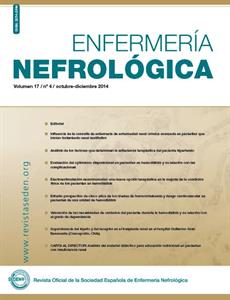Contenido del artículo principal
Resumen
Introducción: Los pacientes en hemodiálisis se caracterizan por una progresiva pérdida muscular y deteriorada condición física. Recientemente, la electroestimulación neuromuscular resulta de gran interés como tratamiento coadyuvante del ejercicio físico en estos pacientes. No existen muchos estudios que avalen el papel de la electroestimulación en el paciente en hemodiálisis.
Objetivos: Analizar el efecto de un programa de electroestimulación neuromuscular sobre la fuerza muscular, capacidad funcional y calidad de vida en nuestros pacientes en hemodiálisis.
Material y métodos: Estudio prospectivo de 12 semanas de duración. 22 pacientes fueron incluidos. 62.8% hombres. Edad media 67.8 años y 35.6 meses de permanencia en hemodiálisis. Índex de Charlson medio: 9. Principales etiologías de la Insuficiencia renal crónica terminal: Hipertensión (13.6%), Diabetes Mellitus (27.3%), Glomerular (18.2%). Los pacientes incluidos realizaron un programa adaptativo de electroestimulación de ambos cuádriceps mediante el dispositivo Compex® Theta 500i. Analizamos: 1.-Datos musculares: Fuerza extensión máxima cuádricep y “Handgrip”. 2.-Test funcionales: “Sit to stand to sit" y “Six-minutes Walking test”. 3.- Síntomas en las extremidades inferiores: Cuestionario Electroestimulación. 4.- Grado satisfacción: Escala Valoración Subjetiva y. Escala Visual Analógica 5.-Calidad de vida: EuroQoL-5D.
Resultados: Al finalizar el estudio, observamSix minuters walking test* (9.5%, 290.5 vs 312.4m). En relación al grado de satisfacción observamos mediante una escala de valoración subjetiva una mejoría del 44% del estado general, un 72% de la condición física y un 80% de las molestias en miembros inferiores, así como la puntuación en el cuestionario de electrostimulación *(8.5 vs 5.8 sint/pac). El grado de satisfacción medio fue 7.8. En relación a la calidad de vida, observamos una mejoría significativa mediante el EuroQol5D* (52.7 vs 65.5%). No se observaron cambios relevantes en los datos bioquímicos o adecuación dialítica al finalizar el estudio.
Conclusiones: La electroestimulación neuromuscular intradiálisis de ambos cuádriceps mejoró la fuerza muscular, la capacidad funcional y la calidad de vida de nuestros pacientes en hemodiálisis. Con los resultados obtenidos, la electroestimulación neuromuscular constituye una nueva alternativa terapéutica para mejorar la condición física y la calidad de vida de éstos pacientes.os una mejoría significativa (*p<0,05) de la fuerza máxima extensión del cuádriceps* (10.2 ± 6.7 vs 13.1 ± 8.1kg),
Objetivos: Analizar el efecto de un programa de electroestimulación neuromuscular sobre la fuerza muscular, capacidad funcional y calidad de vida en nuestros pacientes en hemodiálisis.
Material y métodos: Estudio prospectivo de 12 semanas de duración. 22 pacientes fueron incluidos. 62.8% hombres. Edad media 67.8 años y 35.6 meses de permanencia en hemodiálisis. Índex de Charlson medio: 9. Principales etiologías de la Insuficiencia renal crónica terminal: Hipertensión (13.6%), Diabetes Mellitus (27.3%), Glomerular (18.2%). Los pacientes incluidos realizaron un programa adaptativo de electroestimulación de ambos cuádriceps mediante el dispositivo Compex® Theta 500i. Analizamos: 1.-Datos musculares: Fuerza extensión máxima cuádricep y “Handgrip”. 2.-Test funcionales: “Sit to stand to sit" y “Six-minutes Walking test”. 3.- Síntomas en las extremidades inferiores: Cuestionario Electroestimulación. 4.- Grado satisfacción: Escala Valoración Subjetiva y. Escala Visual Analógica 5.-Calidad de vida: EuroQoL-5D.
Resultados: Al finalizar el estudio, observamSix minuters walking test* (9.5%, 290.5 vs 312.4m). En relación al grado de satisfacción observamos mediante una escala de valoración subjetiva una mejoría del 44% del estado general, un 72% de la condición física y un 80% de las molestias en miembros inferiores, así como la puntuación en el cuestionario de electrostimulación *(8.5 vs 5.8 sint/pac). El grado de satisfacción medio fue 7.8. En relación a la calidad de vida, observamos una mejoría significativa mediante el EuroQol5D* (52.7 vs 65.5%). No se observaron cambios relevantes en los datos bioquímicos o adecuación dialítica al finalizar el estudio.
Conclusiones: La electroestimulación neuromuscular intradiálisis de ambos cuádriceps mejoró la fuerza muscular, la capacidad funcional y la calidad de vida de nuestros pacientes en hemodiálisis. Con los resultados obtenidos, la electroestimulación neuromuscular constituye una nueva alternativa terapéutica para mejorar la condición física y la calidad de vida de éstos pacientes.os una mejoría significativa (*p<0,05) de la fuerza máxima extensión del cuádriceps* (10.2 ± 6.7 vs 13.1 ± 8.1kg),
Palabras clave
hemodiálisis; electroestimulación neuromuscular; debilidad muscular.
Detalles del artículo
Licencia
Aviso de derechos de autor/a
© Los autores ceden de forma no exclusiva los derechos de explotación de los trabajos publicados y consiente en que su uso y distribución se realice con la Licencia Creative Commons Atribución - No comercial 4.0 Internacional (CC BY-NC 4.0). Puede consultar desde aquí la versión informativa y el texto legal de la licencia. Esta circunstancia ha de hacerse constar expresamente de esta forma cuando sea necesario.
Cómo citar
1.
Junqué Jiménez A, Esteve Simón V, Tomás Bernabeu E, Paz López O, Iza Pinedo G, Luceño Solé I, et al. Electroestimulación neuromuscular: una nueva opción terapéutica en la mejoría de la condición física de los pacientes en hemodiálisis. Enferm Nefrol [Internet]. 2014 [consultado 13 Nov 2025];17(4):[aprox. 8 p.]. Disponible en: https://www.enfermerianefrologica.com/revista/article/view/3689




